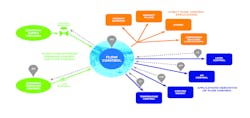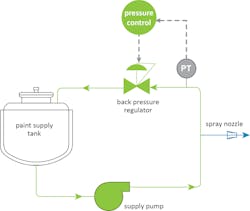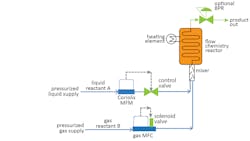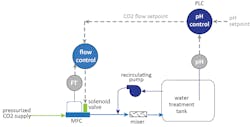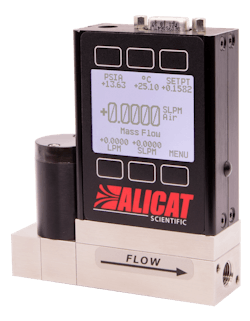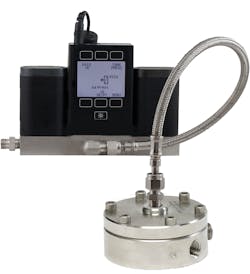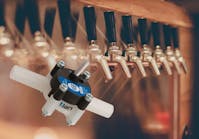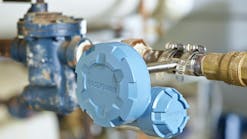Beyond the classroom: An expanded view of flow control
In school, engineers are taught that flow control and pressure control are related but distinct concepts — controlling flow focuses on volume while controlling pressure focuses on force. In real-world applications, however, it is often the interaction between the two that gives innovators an opportunity to create powerful new process methods.
Such opportunities have become even more exciting in recent years. Developments in flow chemistry and continuous manufacturing have put a novel twist on longstanding traditions of steady-state flow control for dosing and inline blending. Expanding the traditional model further extends flow control into level control, temperature control, pH control and even coating weight control.
Interaction between pressure and flow control
As innovators push the envelope to adapt processes, it can be helpful to review how flow control and pressure control systems converge to create new process methods.
The flow chart in Figure 1 provides an overview of the interactions where pressure control assists with flow control, and flow control is then used in either a direct application or to assist in the control of other variables.
As illustrated, pressure and flow often work together to enable a specified outcome. In one configuration, flow may be controlled with a constant supply pressure and a variable resistance such as a control valve or solenoid valve. In another configuration, flow control can be achieved by varying the supply pressure to a fixed resistance.
Constant supply pressure with variable resistance
A large manufacturing plant that processes fluids through several steps provides a classic example of flow control in which a fluid with constant supply pressure is sent to a proportional-integral-derivative (PID) control loop with a flowmeter and a control valve. In this situation, engineers could use a globe-style flow control valve acting upon a relatively constant fluid pressure supplied by a pump or header. The flow control valve adjusts in response to a flowmeter and PID controller, providing variable resistance to achieve a desired flow set point (see Figure 2).
Variable supply pressure with constant resistance
A paint spraying system provides an example of using variable pressure and constant resistance (see Figure 3). A pump is needed to keep fluid paint circulating, and the spray nozzle needs various pressures applied to reach the proper flow. A back pressure regulator (BPR) is often used to control pressure in the recirculating loop with the pump. The resistance of the spray nozzle is considered a fixed resistance, which can be approximated by flow coefficient or an orifice equivalent. Considering that virtually all industrial fluid processes are turbulent (even viscous paint spraying), the flow rate can be approximated as the square root of the applied pressure. The BPR provides the variable pressure to control the flow.
Direct flow control applications and modern flow chemistry
The aforementioned steady-state process control strategies have been used in the chemical industry for decades in processes such as dosing and bottle filling.
During the past 20 years, however, innovative developments have resulted in new ways of taking advantage of the interaction between flow and pressure control. Pharmaceutical, fine chemical and agrochemical industries have accelerated the conversion from batch-style reaction kettles to inline blending and continuous reaction flow chemistry using precise pressure and flow control techniques. These developments have been fueled by the availability of extremely reliable and precise Coriolis flowmeters and the desire for simplified and more flexible processes.
In continuous flow reactor processes, precise flow control of reactants ensures proper ratio control for a consistent reaction resulting in a quality final product. Reactor systems are uniquely designed for equilibrium management, residence time and reaction speed. Designs typically meter reactants through precision liquid Coriolis mass flowmeters (MFM) and gas mass flow controllers (MFC), which are MFMs with an integrated solenoid valve. Fluids are metered into a reactor where the conversion takes place inline and continuously.
In the example in Figure 4, a liquid is supplied at constant pressure through a liquid Coriolis MFM paired with a control valve to control flow. In parallel, a gas at constant supply pressure is metered through a gas MFC to control flow. They are mixed together at the reactor inlet and flow continuously through the reactor. Temperature is controlled to optimize the reaction, and an optional BPR may be used to increase reaction rate or control phases of certain byproducts. This design may be used in processes such as hydrogenation.
A similar design would work for inline product blending where ingredients are metered and blended in a modern steady-state continuous manufacturing process to reach a desired ingredient ratio.
Controlling flow to control other variables
Expanding the pressure and flow control interactions even further, flow control can be used to affect other variables such as pH, level, temperature or coating weight.
The case for cascade control
Cascade control uses two feedback loops, with a primary outer control loop sending a set point signal to the secondary inner control loop. Together, they control the final process variable. Cascade control works well when the inner loop responds quickly to set point changes and is controlling a primary outer loop that is slow to respond to changes (level, temperature, pH, etc).
Cascade control loops are commonly designed so that the secondary inner loop controls flow, and the primary outer loop adjusts the flow set point to achieve desired final process variable. The advantage to this arrangement is that the inner loop will respond quickly to process upsets and send a signal to the outer loop, avoiding large excursions in the final process variable.
pH cascade control application
In one case study, a water treatment facility was designing a pH control system where CO2 would be sparged into a body of water to control the pH of the water. (See Figure 5.) The application involved the need to control mass flow over a wide flow range to cater to various volumes of water, while at the same time, reducing time lag between CO2 injection and pH changes of the water.
For this situation, an Alicat MFC with a 200:1 turndown ratio was used in a cascade design to control pH. (See Figure 6.) The integrated solenoid valve response to feedback from an internal PID in the MFC achieved flow control of the CO2 gas. The set point for the pH was established in a programmable logic controller (PLC). A pH meter in the water signaled to the PLC, which adjusted the setpoint of the MFC to arrive at the prescribed pH.
The wide range of flow control in the MFC allowed the system design to work for various water tank sizes, and the communication capabilities of the MFC facilitated easy pairing to the PLC.
Temperature cascade control
Cooling control loops are ubiquitous in chemical processes and manufacturing plants to control temperature in various systems. From brewing or fermentation chambers to chemical manufacturing plants and even data center cooling, temperature control is an important process variable. Precise cooling liquid flow control can help maintain accurate process temperatures even within a strict operating window.
In a typical cooling or chiller loop, cooling fluids are delivered to the process at a flow rate capable of maintaining the target temperature. In some designs, cooling fluid pressure may be controlled in a recirculating loop using a BPR to control flow, as in the spray nozzle example in Figure 3. The variable pressure through a constant orifice delivers the appropriate flow, which cascades to controlling the final temperature of the process. The process temperature sends a signal to the pressure control loop, which varies to adjust flow to keep the temperature in control.
Expanding the view
While many of these examples are familiar to experienced process engineers, continued improvements in flow control valves, pressure control regulators, meters and automation systems are creating groundbreaking opportunities. By reexamining the way flow and pressure interact, it is often possible to imagine new and innovative ways of using available control components to meet challenging application requirements and develop improved systems for world-class manufacturing.
Jeff Jennings, PE, is founder and president of Equilibar, an engineering company that specializes in precision fluid control for challenging applications around the world. Jennings has more than 30 years of engineering experience including 16 years with The DuPont Company. He holds several international patents and continues active research in the field of fluid controls. He may be reached at [email protected].
Jeff Jennings
Jeff Jennings, PE, is founder and president of Equilibar, an engineering company that specializes in precision fluid control for challenging applications around the world. Jennings has more than 30 years of engineering experience including 16 years with The DuPont Company. He holds several international patents and continues active research in the field of fluid controls. He may be reached at [email protected].
